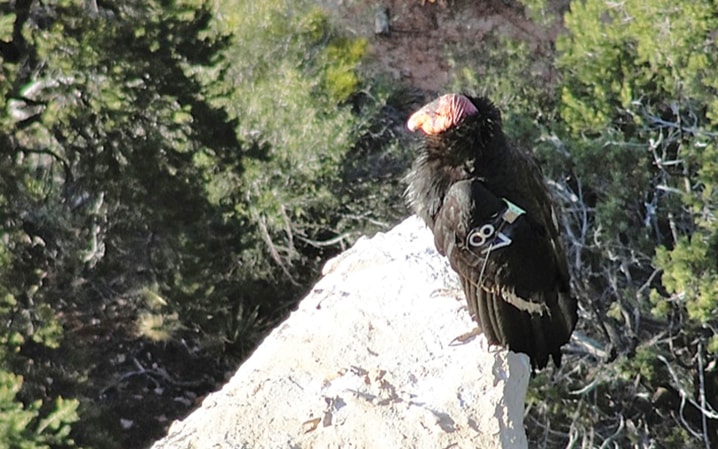With a three-metre wingspan, the California condor is a grand bird for a grand canyon.
Arizona’s Grand Canyon National Park is one of the seven natural wonders of the world. Over four million people come each year to see the kodachrome colours of this gigantic fissure in the Earth’s surface, and it seems appropriate it is home to North America’s largest flying land bird.
During the Pleistocene era, the canyon had a wetter and cooler climate than it does now. Giant sloths and mammoths lived in the area and condors fed upon their carcasses. The sloths and mammoths died out, but condors have been nesting in the area for 50,000 years!
You can be forgiven for thinking the condor was also extinct as the population of wild birds dipped to 22 in the 1980s.
Lucky for us, a variety of conservation groups and government agencies banded together to save the birds from extinction.
First, they captured all the remaining wild birds to focus on a captive breeding program before reintroducing them to the wild. Now, 30 years later, there are approximately 380 birds in the world, with half living in the wild.
Erin Whittaker, park ranger at Grand Canyon National Park, explains, “It was a very emotional experience for the people who captured the last wild condor. But this year, we think we will have the first wild-born chick from a bird that themselves was born in the wild! This bird will have no memory of captivity.”
The California condors have been reintroduced in the Big Sur area of California, Baja California in Mexico, and north Arizona. About 70 of the birds are found in Grand Canyon National Park.
The Grand Canyon is so large that even a bird as big as a condor is not easy to spot; fortunately, there are some birds that favour the cliffs near Grand Canyon Village on the south rim.
“It’s too windy today. You will not see them,” said the gift shop cashier as she rang through my purchases of all things condor-related. “But I’ve seen them several times below Lookout Studio.”
With only one day at the canyon, I could not wait for calm skies, so I walked my binoculars over to the craggy cliffs below Lookout Studio and hoped for the best. The wind tore at my hat and I could understand why a bird would stay home on a day like this, but after 15 minutes, a junior pteradactyl of a bird swooped towards the cliff.
Its bright-red head and the numbers on its black wings (each condor is tagged for scientific purposes) were distinctive field marks and I marvelled at the conditions that allowed tourists to see one of the world’s rarest birds at one of its busiest tourist attractions.
“I think without help, these birds would still die out,” Erin said.
Human impacts are so great on these birds that scientists regularly capture condors to remove coins or lead fragments from their gullets. The birds mistake the coins people toss from the canyon cliffs as bone fragments needed to build calcium during egg production. Condors eat the lead fragments when they gorge on the gut piles left behind by hunters. Now, many hunters are switching to non-lead ammunition and tourists are discouraged from tossing coins.
“Fortunately, the condor reintroduction is a real team effort, and it is a story I love to tell,” Erin concludes. “The story is not finished but there are successes.”
I felt shock and awe as I watched nature’s stealth-bomber swoop towards me in a flight that has been repeated for tens of thousands of years. Judging by the excitement of the tourists sharing this view with me, the chance to witness such a spectacle is success indeed.
Carol Patterson has been speaking and writing about nature tourism and emerging destinations for two decades. When she isn’t travelling for work, she is travelling for fun. More of Carol’s adventures can be found at www.naturetravelgal.com.
